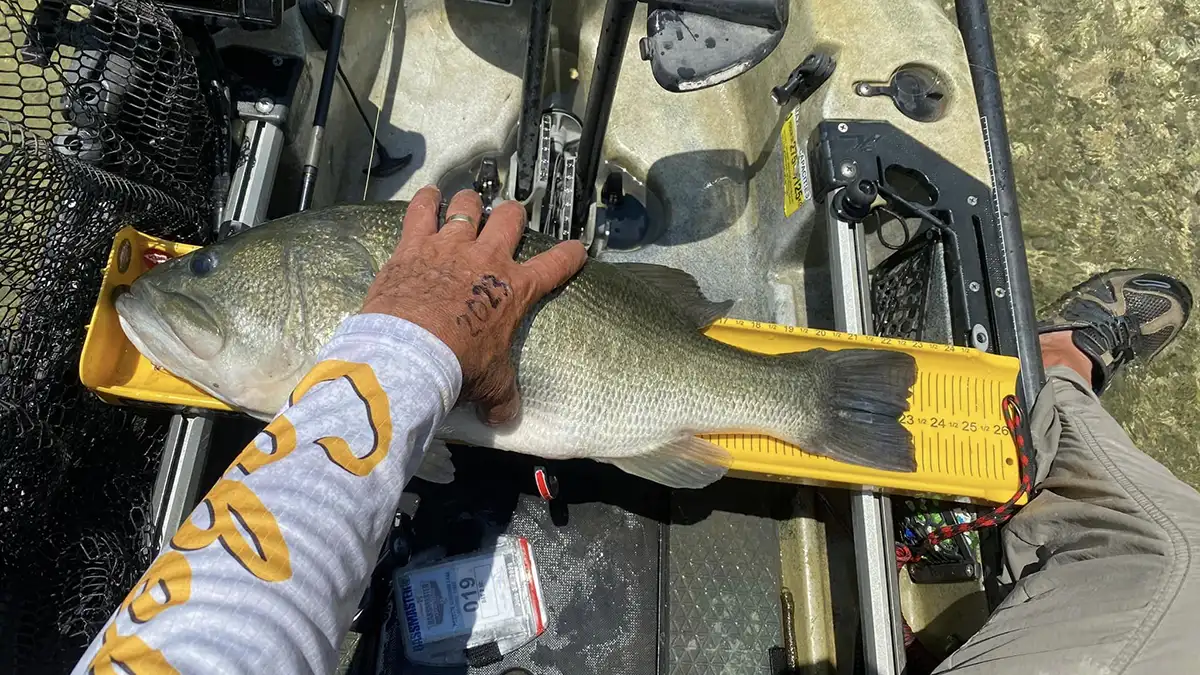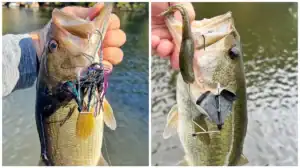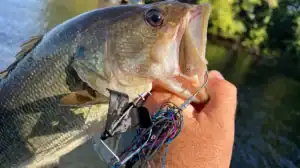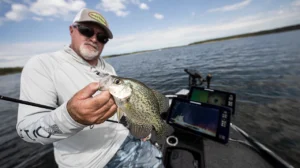Spinnerbaits, the classic component of every well-stocked tackle box, have taken a backseat to umbrella rigs, vibrating jigs, and even Texas-rigged swimbaits in recent years, but they still can create magic. Oklahoma tournament angler Jason Christie proved that when he won the 2025 National Professional Fishing League tournament on South Carolina’s Santee Cooper lakes in March — his first NPFL title.
He fished a BOOYAH Covert Spinnerbait around cypress trees standing in cold water, catching enough bass to set the league’s three-day weight record and take home $100,000.
It’s not the first time that Christie has leaned on a spinnerbait. He used a similar single-spin model to finish second at the 2016 Bassmaster Classic. But that spinnerbait isn’t the only winning combination. Smaller finesse spinnerbaits are better producers in certain situations. Making that happen requires choosing the best one and knowing when and where to fish it.
What’s a Finesse Spinnerbait?

Ask any angler for a finesse lure and you’ll likely be handed a small soft-plastic bait. However, that same unintrusive profile and subtle action can be found in other lure types, including topwaters, crankbaits, and spinnerbaits.
Weight is the easiest way to define a finesse spinnerbait. While Christie’s 1/2-ounce version is too heavy, baits weighing between 3/16- and 3/8-ounce are on the money. There are even smaller options, like Strike King’s Mini-King, an 1/8-ounce single spin that’s caught plenty of pressured bass.
Like their larger cousins, finesse spinnerbaits create the illusion of a small school of baitfish. They also share the same near snag-free design, allowing you to fish through cover without much worry, but it’s their small stature that’s the difference maker. Bass will bite them when bigger spinnerbaits turn them off.
The Common Traits of All Great Finesse Spinnerbaits
While head shape, for example, makes little difference in a spinnerbait’s ability to catch bass, other components affect it very much. So, search out finesse spinnerbaits that have the following:

- Thin wire frame: The frame, which connects all of a finesse spinnerbait’s components, should be made of wire no more than .032 inches thick. That ensures the most vibration from the smallest blades. The frame must also be compact, holding blades just above the skirt. Don’t panic about its relatively small hook (usually 1/0 or 2/0), it’ll bring the biggest bass to your boat.
- Small blades: Willow, Indiana, and Colorado blade shapes in any combination are found on finesse spinnerbaits. They trend small, usually No. 2, No. 3, or No. 4. Metallic finishes are best in clear water and under sunny skies. Use painted blades when wind ripples the surface, the sky is overcast, or the water looks like chocolate milk.
- Tight skirt: Whether silicone, living rubber, or bucktail, a spinnerbait’s skirt helps define its profile. Create a more compact skirt by pulling a few strands from a stock model and trimming the remaining ones, or use one made with thin strands. BOOYAH Pond Magic Spinnerbaits, for example, sport 60 strands of ultra fine silicone.
Two add-ons will make your finesse spinnerbait better. A trailer hook will catch bass that swipe at your bait. It needs to be scaled down — a No. 1 is perfect — and free floating to miss snags. A soft-plastic trailer adds to your bait’s realistic profile and increases its water resistance, holding it higher in the water column when fishing shallow cover. Straight-tailed options, such as a cutdown ringworm or twin tail, are best.
Where to Fish a Finesse Spinnerbait

Versatility is a spinnerbait’s strongest attribute. You can find one that matches nearly every bass-fishing situation. Finesse spinnerbaits are no different and excel in these four spots:
- Slow-moving rivers: Look no further than the Ohio, where anglers fight through tough fishing with finesse spinnerbaits, including well-known models made by Tim Poe. Work baits with Colorado and trailing Indiana blades below current breaks, particularly main river laydowns in summer and fall.
- Tidal waters: This might be the best place for a finesse spinnerbait. Retrieve it around manmade cover, such as pilings and seawalls, or aquatic vegetation, including milfoil clumps and pad stems, during the first few hours of an outgoing tide. A single or a pair of hard-thumping Colorado blades work best in the frequently off-colored water.
- Riprap banks: Give bass holding here something besides a square-bill crankbait to chase. Key-in on points, pockets, or associated cover like a log that washed ashore. Cuts that lead to backwaters are best in fall. Go with a single blade in summer. Retrieve it slowly, allowing it to sink as it advances, following the bank’s natural taper toward deep water.
- Shallow cover: Probe laydowns and the first sprouts of aquatic vegetation in the back of bays and creeks when prespawn bass are searching for beds and post-spawners are guarding fry. Focus on similar spots in reservoirs during fall, when bass are schooling on shad and most anglers are using small crankbaits. Tandem willow blades are best in the usually clear water.
Gear Up For Finesse Spinnerbaits: Rod, Reel, and Line

Step one is choosing the best finesse spinnerbait for where and when you’re fishing. Next, you need to put it in front of bass. That’s usually done with a short overhand or roll cast, and a baitcasting rod does both best.
You’ll need a rod capable of casting relatively lightweight finesse spinnerbaits. Trika’s 6X rod that measures 6 feet and 10 inches is a good example. It’s rated for lures as light as 1/4-ounce — a 3/16-ounce model will weigh that when a trailer and trailer hook are added — and up to 17-pound-test line. If you want to fish an even smaller spinnerbait, try Trika’s 7-foot Bait Finesse System rod, which is rated for lures weighing 1/16- to 5/16-ounce, and line from 4- to 8-pound test.
Match both rods to a small baitcasting reel that casts easily. Daiwa’s Tatula SV100, for example, casts lightweight lures farther thanks to a two-stage braking system and a specially designed spool. Its 6.3:1 gear ratio makes cranking at medium speeds, which won’t overwhelm small blades, more comfortable than trying to slow down a reel with bigger gears.
Fill your reel with fluorocarbon or braided line. While you can get away with 8-pound test when cover is sparse, don’t hesitate to push 15- or 20-pound test when targeting piers, laydowns, or thick aquatic vegetation. You’ll appreciate the durability around heavy cover and sensitivity when a bass engulfs your spinnerbait and swims toward you.
Three Tips for Catching More with Finesse Spinnerbaits
There’s a rhythm to fishing finesse spinnerbaits. As you fish along, picking apart targets, you must make the most of every cast. Accomplish that by adding these to each one:
- Accuracy: Finesse spinnerbaits struggle to call bass from a distance. So, the importance of putting your bait on a bass’s nose, whether that’s perfectly in the crotch of a laydown or clump of aquatic vegetation, can’t be understated, because it overstates its presence.
- Speed: Lightweight finesse spinnerbaits and small blades are easily overwhelmed by a speedy retrieve. Turn yours just fast enough to keep the blades spinning while maintaining your target depth.
- Repetition: You may luck out with a one and done cast, but you’ll reap more with multiple casts to every good-looking spot. Add variety to each by shaking your rod tip so your bait’s skirt flairs and blades stumble, or by slightly altering the angle your finesse spinnerbait crosses an ambush point.










